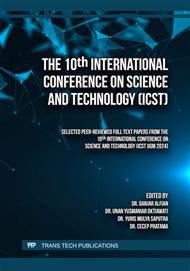[1]
L. H. A. Al-Ttaffi, S. A. Bin-Nashwan, and M. R. Amrah, "The influence of tax knowledge on tax compliance behaviour: A case of yemeni individual taxpayers," Journal of Business Management and Accounting, vol. 10, no. 2, pp.15-30, 2020.
DOI: 10.32890/jbma2020.10.2.2
Google Scholar
[2]
L. Batrancea, A. Nichita, J. Olsen, C. Kogler, E. Kirchler, E. Hoelzl, A. Weiss, B. Torgler, J. Fooken, J. Fuller, et al., "Trust and power as determinants of tax compliance across 44 nations," Journal of Economic Psychology, vol. 74, p.102191, 2019.
DOI: 10.1016/j.joep.2019.102191
Google Scholar
[3]
M. Bellon, E. Dabla-Norris, S. Khalid, and F. Lima, "Digitalization to improve tax compliance: Evidence from vat e-invoicing in peru," Journal of Public Economics, vol. 210, p.104661, 2022.
DOI: 10.1016/j.jpubeco.2022.104661
Google Scholar
[4]
P. Lois, G. Drogalas, A. Karagiorgos, and A. Chlorou, "Tax compliance during fiscal depression periods: the case of greece," EuroMed Journal of Business, vol. 14, no. 3, pp.274-291, 2019.
DOI: 10.1108/emjb-02-2019-0028
Google Scholar
[5]
H. T. H. Le, V. T. B. Tuyet, C. T. B. Hanh, and Q. Hung, "Factors affecting tax compliance among small-and medium-sized enterprises: Evidence from vietnam," The Journal of Asian Finance, Economics and Business (JAFEB), vol. 7, no. 7, pp.209-217, 2020.
DOI: 10.13106/jafeb.2020.vol7.no7.209
Google Scholar
[6]
E. Carsamer and A. Abbam, "Religion and tax compliance among smes in ghana," Journal of Financial Crime, vol. 30, no. 3, pp.759-775, 2023.
DOI: 10.1108/jfc-01-2020-0007
Google Scholar
[7]
A. Ghosal, A. Nandy, A. K. Das, S. Goswami, and M. Panday, "A short review on different clustering techniques and their applications," Emerging Technology in Modelling and Graphics: Proceedings of IEM Graph 2018, pp.69-83, 2020.
DOI: 10.1007/978-981-13-7403-6_9
Google Scholar
[8]
M. Ahmed, R. Seraj, and S. M. S. Islam, "The k-means algorithm: A comprehensive survey and performance evaluation," Electronics, vol. 9, no. 8, p.1295, 2020.
DOI: 10.3390/electronics9081295
Google Scholar
[9]
X. Zhang and D. J. Hill, "Clustering of uncertain load model parameters with k-medoids algorithm," in 2018 IEEE Power & Energy Society General Meeting (PESGM), pp.1-5, IEEE, 2018.
DOI: 10.1109/pesgm.2018.8586038
Google Scholar
[10]
K. S. Dorman and R. Maitra, "An efficient k-modes algorithm for clustering categorical datasets," Statistical Analysis and Data Mining: The ASA Data Science Journal, vol. 15, no. 1, pp.83-97, 2022.
DOI: 10.1002/sam.11546
Google Scholar
[11]
D. P. Ismi and M. Murinto, "Clustering based feature selection using partitioning around medoids (pam)," Jurnal Informatika Ahmad Dahlan, vol. 14, no. 2, pp.50-57, 2020.
DOI: 10.26555/jifo.v14i2.a17620
Google Scholar
[12]
K. Djouzi and K. Beghdad-Bey, "A review of clustering algorithms for big data," in 2019 International Conference on Networking and Advanced Systems (ICNAS), pp.1-6, IEEE, 2019.
DOI: 10.1109/icnas.2019.8807822
Google Scholar
[13]
A. E. Ezugwu, A. M. Ikotun, O. O. Oyelade, L. Abualigah, J. O. Agushaka, C. I. Eke, and A. A. Akinyelu, "A comprehensive survey of clustering algorithms: State-of-the-art machine learning applications, taxonomy, challenges, and future research prospects," Engineering Applications of Artificial Intelligence, vol. 110, p.104743, 2022.[14] A. K. Jain, M. N. Murty, and P. J. Flynn, "Data clustering: a review," ACM computing surveys (CSUR), vol. 31, no. 3, pp.264-323, 1999.
DOI: 10.1016/j.engappai.2022.104743
Google Scholar
[15]
P. Govender and V. Sivakumar, "Application of k-means and hierarchical clustering techniques for analysis of air pollution: A review (1980-2019)," Atmospheric pollution research, vol. 11, no. 1, pp.40-56, 2020.
DOI: 10.1016/j.apr.2019.09.009
Google Scholar
[16]
H. Teichgraeber and A. R. Brandt, "Clustering methods to find representative periods for the optimization of energy systems: An initial framework and comparison," Applied energy, vol. 239, pp.1283-1293, 2019.
DOI: 10.1016/j.apenergy.2019.02.012
Google Scholar
[17]
K. G. Al-Hashedi and P. Magalingam, "Financial fraud detection applying data mining techniques: A comprehensive review from 2009 to 2019," Computer Science Review, vol. 40, p.100402, 2021.
DOI: 10.1016/j.cosrev.2021.100402
Google Scholar
[18]
X. Huang and H. Tang, "Measuring multi-volatility states of financial markets based on multifractal clustering model," Journal of Forecasting, vol. 41, no. 3, pp.422-434, 2022.
DOI: 10.1002/for.2820
Google Scholar
[19]
H. Alashwal, M. El Halaby, J. J. Crouse, A. Abdalla, and A. A. Moustafa, "The application of unsupervised clustering methods to alzheimer's disease," Frontiers in computational neuroscience, vol. 13, p.31, 2019.
DOI: 10.3389/fncom.2019.00031
Google Scholar
[20]
M. Halkidi, Y. Batistakis, and M. Vazirgiannis, "On clustering validation techniques," Journal of intelligent information systems, vol. 17, pp.107-145, 2001.
DOI: 10.1023/a:1012801612483
Google Scholar
[21]
N. Uddin, A. Dwianika, I. P. Sofia, and R. Tchamna, "Classification of corporate tax compliance in indonesia based on k-nearest neighbors algorithm," in 2023 IEEE World AI IoT Congress (AIIoT), pp.297-304, IEEE, 2023.
DOI: 10.1109/aiiot58121.2023.10174541
Google Scholar
[22]
J. Blömer, C. Lammersen, M. Schmidt, and C. Sohler, "Theoretical analysis of the k-means algorithm-a survey," Algorithm Engineering: Selected Results and Surveys, pp.81-116, 2016.
DOI: 10.1007/978-3-319-49487-6_3
Google Scholar
[23]
A. Dwianika, I. P. Sofia, N. Uddin, and I. Retnaningtyas, "The impact of social identity on tax compliance in indonesia during the pandemic covid-19," International Journal of Professional Business Review: Int. J. Prof. Bus. Rev., vol. 8, no. 4, p.4, 2023.
DOI: 10.26668/businessreview/2023.v8i4.1113
Google Scholar
[24]
A. Dwianika, I. P. Sofia, N. Uddin, and I. Retnaningtyas, "The identity social of tax compliance: How it impacts manufacturing business," KnE Social Sciences, pp.734-742, 2023.
DOI: 10.18502/kss.v8i12.13720
Google Scholar
[25]
M. Fishbein and I. Ajzen, "Belief, attitude, intention, and behavior: An introduction to theory and research," 1977.
Google Scholar


